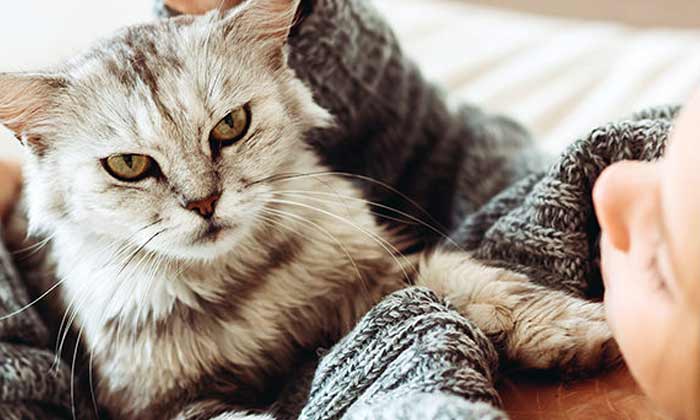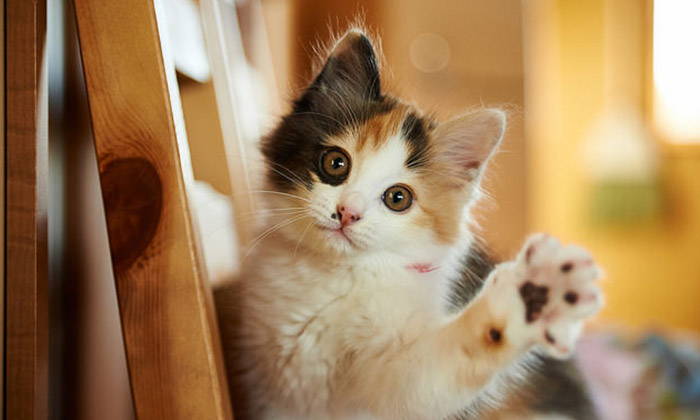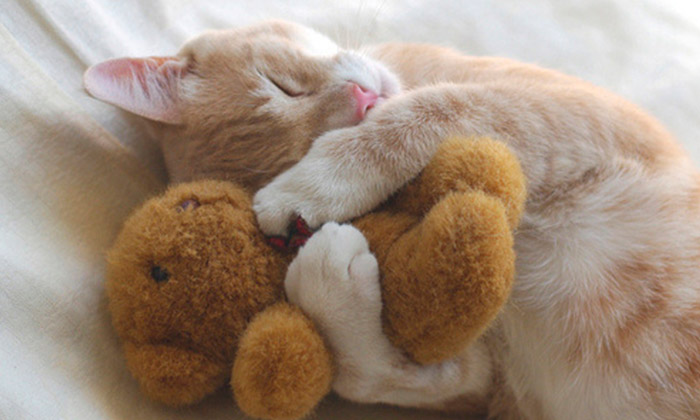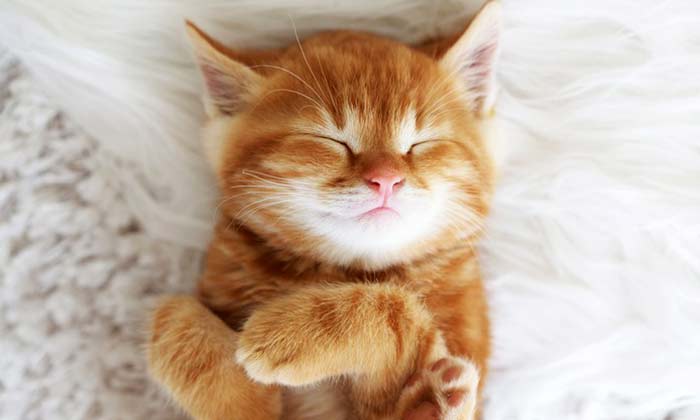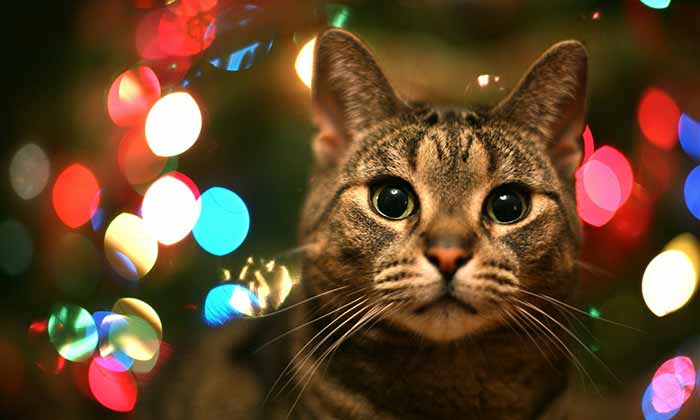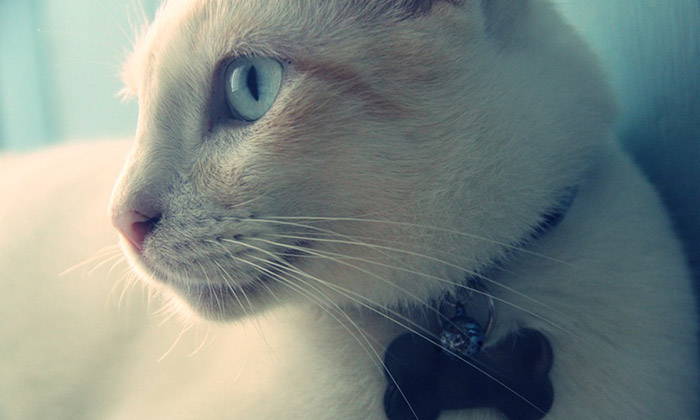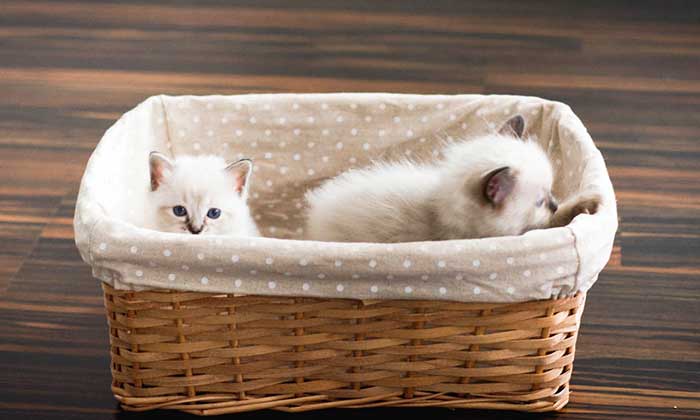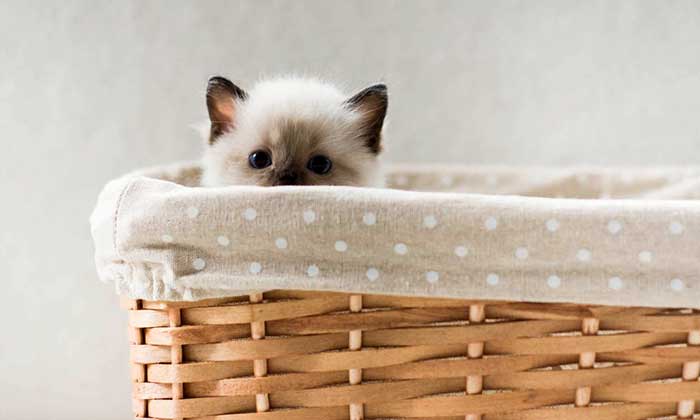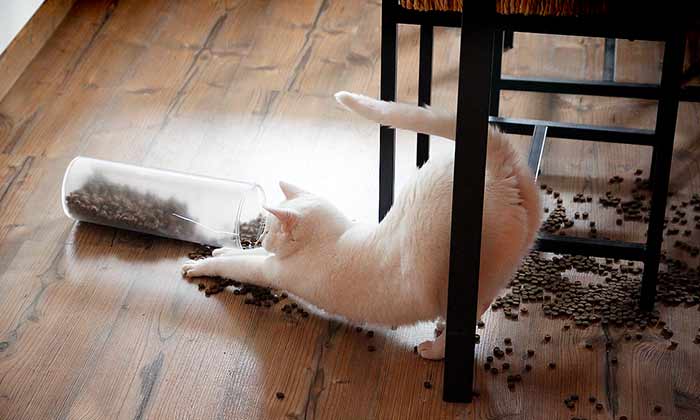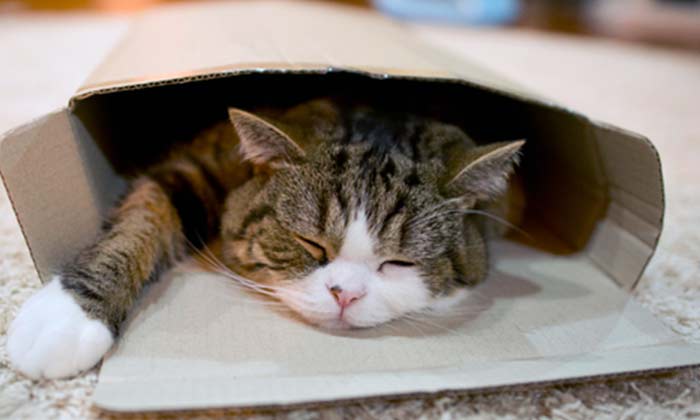Pregnant Cat: How to Tell if Your Cat is Pregnant
You ask yourself how to tell if you have a pregnant cat? Understanding pregnant cat behavior is a little easier once you know the gestation period of a cat, and what to expect during each of the weeks. Once a cat has conceived, it will display different behavior for an average of 65 days.
The behavioral changes in pregnant cats do not vary so much from those of humans, just that they happen over a shorter period of time, and require one to be very observant. If you are not alert, you may miss the pregnant cat behavior and suddenly find your cat in your linen closet with a litter of kittens.
How To Tell if Your Cat Is Pregnant
1. Change in Appetite
Behavioral changes in pregnant cats affect their appetite. For the most part, their appetite will increase. If your cat is still hungry after completing their normal ration of food, she may be pregnant. Morning sickness is pregnant cat behavior that may plague your cat, but only for a couple of weeks. During this time her appetite may reduce significantly.
2. Lethargy and Irritation
The behavior of pregnant cats will vacillate between affection, irritation and lethargy. Your normally active cat will spend a lot more time sleeping, and she will be very calm and quieter than usual. The display of irritability in your cat is one of the less pleasant behavioral changes in pregnant cats. One minute she will be looking for attention and then if you handle her too much, she will get irritated.
3. Swollen Abdomen and Enlarged Nipples
A distended belly and larger nipples do not qualify as pregnant cat behavior, but they are some of the signs that will alert you to the fact that your cat may be pregnant and is not just growing fat and comfortable. About three weeks after conceiving, your cat’s nipples will enlarge and turn pink.
 4. Desire For Privacy
4. Desire For Privacy
The desire for privacy is a behavior of pregnant cats that will cause them to withdraw and want to be alone. Your cat knows that soon it will require energy to deliver and take care of kittens and tries as much as possible to preserve its energy.
5. Nesting
Restlessness is expectant cat behavior that signals the nesting phase of pregnancy. This occurs closer to the time of delivery when your cat will start looking around for safe, hidden and comfortable places where she can have her kittens. The key to spotting this pregnant cat behavior is the disappearance of your cat for long periods of time only for them to be discovered in a secluded place.
More signals that your cat may be pregnant
- Roughly 15-18 days into the pregnancy of a cat, the cat’s nipples are likely to grow bigger and turn red. This effect is called “pinking-up.”
- As in humans, pregnant cats can experience morning sickness during which they vomit regularly. If this sickness becomes very frequent or prolonged, or if you notice any other types of sickness, take your cat to the vet.
- The cat’s stomach will start to grow as the kittens inside get bigger. Don’t touch the stomach during the pregnancy to avoid harming your cat or her kittens inside. Of course, stomach swelling is a symptom of many other problems, so if you notice anything unusual or become concerned in any way contact your vet.
- You can expect your pregnant cat to gain about 1-2kg during the pregnancy, although this figure varies based on the number of kittens she is carrying. This is often the most obvious sign that your cat is pregnant.
- You will likely notice that your cat’s appetite increases if she is pregnant, particularly later on in the pregnancy. This will further increase her weight, but may also be symptomatic of other problems such as worms, so contact your vet if anything seems unusual.
- Pregnant cats have been known to become more affectionate and maternal, so your cat may purr more and want more attention from you if pregnant.
- A cat pregnancy can be detected as early as 15 days in using an ultrasound machine. By 40 days your vet should be able to detect the number of kittens your cat is expecting. Of course, this process is difficult and not perfect, as big kittens can hide other smaller kittens in the womb.
Your cat should be perfectly able to handle her labor and birth, but you should prepare yourself nevertheless as she gets closer to birth. You should be able and ready to step in if there are any problems or provide any comforting words if your cat becomes distressed.
Managing Pregnant Cat Behavior
Once you confirm that your cat is pregnant, you can anticipate and manage the varying behaviors of an expecting cat. Not too much is required of you when your cat is expecting other than to let it be, and ensure that it is comfortable and well fed. Follow her lead and give your cat attention when it is requested. If you find her sleeping or hiding away, ignore her and go on with your tasks. In a few weeks, once she has delivered her kittens and they have matured a little, she will be back to her normal playful self.

After the pregnancy is confirmed, you need to decide what is best for your cat going forward. Abortion is one option that you can discuss with your vet and other members of your family. The other choice is to go forward with the pregnancy and have your cat deliver her kittens.
If you choose to go forward and deliver the kittens, you should make plans as soon as possible regarding what to do with the kittens after they are born. You could keep the kittens yourself, sell them or send them to a local shelter or rescue for help. You will also need to organize vet checks for the kittens, along with vaccination and medical plans and plan for the dietary needs of the kittens.
The diet you maintain for your pregnant cat is also important. It must be rich with nutrients, and your cat must have access to fresh, and clean water throughout her entire pregnancy. Higher quality food is needed as your cat gets ready for birth (in the last 2-3 weeks of the pregnancy), although you may notice your cat eats a smaller amount in each sitting (although will likely eat more often). You should plan to keep your cat indoors in the last stages of the pregnancy to keep your cat and her unborn kittens safe.
Normal domesticated short- and long-haired cats tend to be very fertile, producing four to five kittens in each litter. Siamese cats tend to have larger kittens. Other more specialist breeds such as Persians are less fertile on general.
Is my cat likely to run into problems during her pregnancy?
It is rare for most cats to have problems during pregnancy and birth, with Persian cats being an exception. 99% of all cats have no problems and need no help, but staying informed will alleviate any worries you have during this process. The information listed below will help you keep track of the pregnancy and help you ensure that it is successful.
Early in the pregnancy
The gestation of cat pregnancies is approximately 64 days or between 9 and 10 weeks. The earliest signs of pregnancy tend to appear 3 weeks in, including swelling and pinking up of the nipples.
By week 4 and 5, you should notice enlarging of the stomach. You should keep your pregnant cat in a stress-free environment during this time and feed her high-quality cat food. A dry kibble should suffice – you should leave it out all day and allow your cat to eat as much as she likes. We have other articles on orphan kittens and pregnant cat care should you want more information about how to provide for your cat during this time.
Should my cat be examined by a vet?
Getting your cat checked by a vet early in her pregnancy is always a good idea to check her overall health and readiness for birth. By day 26 of the pregnancy, your vet should be able to feel the developing fetuses which present as small round lumps in the oviducts. Your vet will also use an ultrasound if necessary which can more accurately check and count the developing kittens. By day 45, the skeletons of the kittens should have properly calcified and thus will be visible on an X-ray. Using an X-ray is not suitable for counting the number of kittens as the risks from the radiation are too high for a normal pregnancy. This will only be used if a problem is suspected.
What should I do before labor begins?
Should you want to be involved in your cat’s labor and birth, you should start to take your cat’s temperature once a day at the same time for two weeks before the due date. To do this, lubricate the thermometer with margarine or KY jelly, and put it approximately half an inch into your cat’s rectum. After leaving it there for 3 minutes, check the temperature reading. It should be between 101F (38.3C) and 102F (39C). When the reading drops below 100F (37.8C), expect the kittens to arrive within 24 hours.
Your cat will gain between 2 and 4 pounds during the pregnancy, which will equate to about 20-25% of her normal weight. Pregnant cats are good at regulating their food intake, but keep an eye on your cat’s eating habits to ensure she does not get too fat.
What should I expect during delivery?
24 to 48 hours before the start of labor, your cat may appear stressed and restless. It may appear to be poking around your house to look for a good place to give birth – although this behavior can appear a bit earlier. When you notice this behavior starting, keep your cat in a single room in which she will give birth. This room should be dark, have an impervious floor, and be quiet and an ambient temperature. You should leave her food and water in the room too, and give her time to get used to the surroundings.
As labor approaches, your cat will start heavily licking her stomach and vagina. This will mean that pre-birth discharge is quickly cleaned away. Her cervix will start to dilate as labor progresses, but this will not be clear from the outside. Under no circumstances should you use your fingers to try to feel how dilated she is?
As labor continues, your cat will lose interest in food and will only engage in licking herself. Her breathing rate will also increase. Often cats in labor will sit around with their mouths open, or may loudly yell or pace around the room. When contractions commence, your mother cat should lay down on her side and begin to squat to try to push downwards to give birth to the kittens. Stay away from your cat and let her get on with this alone.
How long should I wait?
After one hour of labor, your mother cat should have welcomed her first kitten. Labor time can vary, with the very shortest lasting only a few minutes. Each subsequent kitten should arrive within 10 minutes to an hour of each other.
 When each kitten is born, it will emerge surrounded by an amniotic sack, which looks like a membrane made of jelly filled with a clear fluid. Your cat should instinctively start to lick her new kittens very strongly, which should remove this sac and allow the new kitten to breathe. This licking also kicks off the kitten’s circulation.
When each kitten is born, it will emerge surrounded by an amniotic sack, which looks like a membrane made of jelly filled with a clear fluid. Your cat should instinctively start to lick her new kittens very strongly, which should remove this sac and allow the new kitten to breathe. This licking also kicks off the kitten’s circulation.
Very rarely this instinct does not occur, and the mother won’t lick her kitten to clean it. If this happens, you should use a soft towel and vigorously rub the kitten and its mouth to start its breathing. Bear in mind kittens are very fragile though, so don’t rub too hard or for longer than necessary.
Your mother cat should also instinctively chew off the umbilical cord after birth. If this doesn’t happen, you can tie off the cord using dental floss, and cut down the cord to about an inch long. Overall though you should wait as long as possible to allow the mother to do this for herself, as this encourages a strong bond between the mother and kitten and allows the mother to recognize the kittens as her own. It also stimulates milk flow.
Nursing will start as soon as each kitten is born, on the whole, before the next kitten arrives. You can encourage this to happen faster by putting the kitten on her nipples. This nursing process will further encourage your cat’s uterus to contract more, which can force out a bloody or green-colored discharge fluid from her vagina. Don’t be alarmed if after all of this your cat eats some of the afterbirths – this is unappetising but normal.
The whole labor process of a pregnant cat tends to last 2 to 6 hours, by which time the whole litter should be delivered. If labor lasts longer than 7 hours, you should take the mother and all the kittens to a vet as soon as possible. Otherwise, throughout the labor, keep the delivery room quiet, calm and dark, and stay out of your cat’s way. Only after all the kittens have been delivered should you start cleaning up. Replace the food and water in this room and leave your new mother cat and her kittens alone, as she will want to stay close to and bond with her kittens for the first few days.
What will I see?
Your cat will nurse her kittens for about 70% of her time. You should keep the room warm but not too hot, as kittens cannot easily regulate their body temperatures.
During a normal delivery, strong uterine and abdominal contractions expel the kittens. You will first see a small green sac in the vagina after which come the kittens. The placenta will be attached to the kittens, which will gradually come out throughout the births.
Delivery of each kitten can last up to 2 hours, but the average time is 30 to 60 minutes. Each kitten should be out within 15 minutes, as it cannot survive for longer than this in the birth canal due to pressure on the cord and resulting lack of oxygen. If a kitten seems stuck, you should gently grab it with a soft cloth, and pull it backward and downwards. Hold onto the kitten’s hips and shoulders as far as possible, as the head and legs are too delicate. Kittens will arrive either head first or tail first.
A bloody fluid may be released from the mother cat for up to 10 days after birth. Your cat should automatically lick this up. Take your cat to a vet if this fluid starts to look more like pus or has a strong odor.
Things to keep on hand when your cat is expecting
A large supply of clean towels is useful to keep around when your cat is expecting. Tame iodine solution, which can be found at any normal department store, is good for antiseptic, and Q-tips and blunt scissors can also be useful tools. A package of dental floss is important in case there is a problem with the umbilical cord. Finally, purchase a nose suction bulb and heating pad, to help with cleaning mucus from kittens’ mouths and for keeping them warm.
Potential Cat Pregnancy Problems
As with humans, there can sometimes be problems with a cat’s pregnancy. You should be prepared with the knowledge to identify risks so you know what to do to help and when you should take your cat to an emergency vet.
You should call your vet if something happens differently to those events described above. Other reasons to call the vet are listed below.
Eclampsia is a very dangerous condition for a pregnant cat which can be identified through symptoms such as restlessness, pacing, panting, drooling, loss of balance, spasms in the muscles or seizures. This condition can cause the kittens to naturally abort, or miscarry. Also look for signs such as fever, bleeding, or changes in behavior. If this condition appears early in labor, it can be possible for the mother to absorb the dead fetuses back into its body.
Other problems regarding a pregnant cat include:
- A pregnancy that lasts for more than sixty-six days.
- The temperature of the mother cat stays below 100F for over a day or falls under 98F.
- The mother cat stops eating or becomes sad, weak or drowsy.
- A kitten that stays in the birth canal for more than 10 minutes and does not come out after you try gently pulling it out.
- The mother has contractions for over four hours with no signs of any more kittens.
- Five hours pass with no birth when you are sure there is still another kitten inside the mother.
- Discharge from the vagina develops a strong odor or seems infected.
- Fewer placentas are birthed than there are kittens.
- A kitten refuses to nurse or seems to be weak.
- One of your cat’s mammary glands (breasts) becomes hot, hard or painful.
- Kittens make constant mewing noises, cannot sleep, or become upset.
- Kitten stomachs appear not plump, indicating they are not nursing enough.
- The mother cat’s temperature rises to over 102.5F two or more days after birth.
As long as you keep all this in mind, you will be the proud and happy “parent” of new kittens and will get to experience the joy of many cute kittens running around. Kittens will be physically weak and lack an immune system at this early stage, so be careful when handling them and don’t allow lots of new people to play with them closely. The mother cat may also become aggressive if she feels her new kittens are under threat.
How was your first cat pregnancy? Share your experience in the comments!

